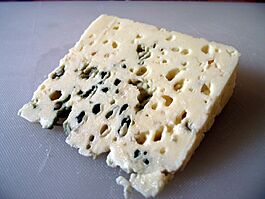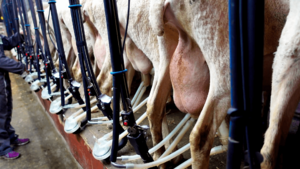Roquefort facts for kids
Quick facts for kids Roquefort |
|
|---|---|
 Roquefort  Texture of Roquefort |
|
| Country of origin | France |
| Region | Aveyron |
| Town | Roquefort-sur-Soulzon |
| Source of milk | Ewe (sheep) |
| Pasteurised | No |
| Texture | Semi-hard |
| Aging time | 5 months |
| Certification | AOC: 1925 |
| Named after | Lua error in Module:Wikidata at line 70: attempt to index field 'wikibase' (a nil value). |
Roquefort is a famous blue cheese from southern France. It is made only from sheep milk. Even though similar cheeses are made in other places, a special law in Europe says that only cheese aged in the natural Combalou caves of Roquefort-sur-Soulzon can be called "Roquefort." This is because it has a "protected designation of origin," which means its name is protected based on where and how it's made.
Roquefort cheese is white and has blue mold veins. It is tangy, creamy, and a bit moist. It has a strong smell and a sharp, unique taste. The outside of the cheese is edible and a little salty. A typical wheel of Roquefort weighs about 2.5 to 3 kilograms (5.5 to 6.6 pounds). It is about 10 centimeters (4 inches) thick. To make one kilogram of this cheese, about 4.5 liters of milk are needed. In France, people often call Roquefort the "king of cheeses."
Contents
History of Roquefort Cheese
How Roquefort Was Discovered
A popular story says that Roquefort cheese was found by accident. A young shepherd was eating his lunch of bread and sheep's milk cheese. He saw a beautiful girl far away and ran to meet her. He left his meal in a nearby cave. When he came back months later, a special mold had grown on his plain cheese. This mold had turned it into the blue cheese we now know as Roquefort.
Early Mentions of French Cheese
In ancient times, around 79 AD, a writer named Pliny the Elder wrote about popular cheeses from the Lozère and Gévaudan regions of France. Some people think he might have been talking about an early version of Roquefort. However, it is not clear if he was describing a blue cheese.
Royal Protection for Roquefort
By the Middle Ages, Roquefort was already a well-known cheese. On June 4, 1411, King Charles VI gave special rights to the people of Roquefort-sur-Soulzon. This meant they had the only right to age this cheese, a tradition they had followed for hundreds of years.
Growth of Roquefort Production
In 1820, about 300 tons of Roquefort were made each year. This amount grew steadily. By 1914, production had increased to 9,250 tons.
Protecting the Name and Quality
In 1925, Roquefort became the first French cheese to receive an "Appellation d'Origine Contrôlée" (AOC). This meant that rules were set to control how it was made and named. In 1961, a very important court decision was made. It said that even if the cheese-making method was used elsewhere, only cheeses aged in the natural caves of Mont Combalou in Roquefort-sur-Soulzon could be called Roquefort. This rule helped protect the cheese's unique quality and origin.
How Roquefort Is Made
Roquefort cheese is made only from the milk of the Lacaune breed of sheep. Before the AOC rules in 1925, sometimes a small amount of cow's or goat's milk was added. About 4.5 liters (1.2 US gallons) of milk are needed to make one kilogram of Roquefort.
Roquefort is produced in the Aveyron area and parts of nearby regions in France. As of 2009, there were seven companies making Roquefort. The largest producer is Société des Caves de Roquefort. Other well-known producers include Papillon and Carles.
In 2005, about three million wheels of Roquefort were made. This made it France's second most popular cheese, after Comté. Roquefort has a lot of a natural flavor enhancer called glutamate. This gives it a rich, savory taste.
Many recipes in the Aveyron region use Roquefort cheese. It is used in sauces for meat, savory tarts, quiches, pies, and fillings.
Special Rules for Roquefort Production
The rules for making Roquefort cheese are set by the AOC. These rules ensure the cheese's quality and unique character. Here are some of the main rules:
- All milk must be collected at least 20 days after the sheep have given birth.
- The sheep must graze in pastures whenever possible. These pastures must be in a specific area that covers most of Aveyron and parts of nearby regions. At least 75% of the food given to the sheep must come from this area.
- The milk must be whole and raw. This means it cannot be heated above 34°C (93°F). It also cannot be filtered, except to remove large pieces.
- A special ingredient called rennet must be added to the milk within 48 hours of milking.
- The specific mold, Penicillium roqueforti, used to make the blue veins must come from the natural caves of Roquefort-sur-Soulzon in France.
- The cheese must be salted using dry salt.
- The entire process of aging, cutting, packaging, and cooling the cheese must happen in the town of Roquefort-sur-Soulzon.
Health Benefits of Roquefort
The mold in Roquefort, Penicillium roqueforti, does not make the medicine penicillin. However, people in the past believed it had healing properties. Shepherds in country areas would sometimes put this cheese on wounds to help prevent serious infections.
Modern studies have looked into these beliefs. A study from 2012 found that Roquefort contains compounds that can help reduce swelling. Another study from 2013 suggested that proteins from Roquefort cheese might help stop certain bacteria from growing.
See also
 In Spanish: Queso roquefort para niños
In Spanish: Queso roquefort para niños




